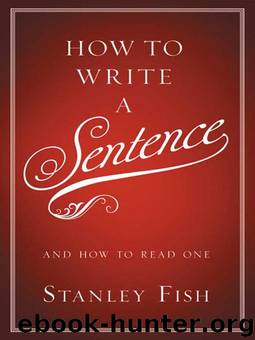How to Write a Sentence: And How to Read One by Stanley Fish

Author:Stanley Fish
Language: eng
Format: mobi, epub
Tags: Reference
ISBN: 0061840548
Publisher: Harper Collins, Inc.
Published: 2011-01-25T00:00:00+00:00
(1925)
Is this a sentence? It doesn’t have a beginning, middle, or end, and as you read it you can’t chart its progress toward a designed close. Who says “she was positive”? Is it Mrs. Dalloway, declaring her certainty to herself ? Is it Woolf, standing outside her character and pronouncing authoritatively on Mrs. Dalloway’s inner state? The questions are unanswerable, for as Auerbach observes, “we are given not merely one person whose consciousness . . . is rendered, but many persons, with frequent”—and, I would add, unannounced—“shifts from one to the other.” For a second, when “Did it matter then” is followed by “she asked herself,” we seem to be in the company of a conventional narrator-novelist who reports the speech of her character. But then “did it matter” is repeated, and it is clear that what we’re hearing is a musing. The perspective now ruling is an interior one; even though the third-person pronoun “she” carries the train of thought along, we sense that this is merely her form of self-reference. A sequence like “she survived, Peter survived” shows how it is done. “She survived” might be spoken by a narrator, but “Peter survived” is obviously uttered by someone who shares an intimacy with him; we cannot believe that the observation is made at a distance, by a third person, but then again, “lived in each other” seems to belong at once to Mrs. Dalloway and to her creator.
As the sentence continues, Mrs. Dalloway shares an intimacy not only with Peter but with everything—a house, trees, people, mist, branches—all of which “ebb and flow” with her and through her. Everything enters her, and she enters everything. Near its end the sentence names the action it is imitating; it spreads; she spreads, “ever so far, her life, herself.” Formally, the sentence is fragmentary; no, it is fragments, held together barely by a soft “but,” which is more like an “and,” many participles, many ofs, all tumbling forward, all jumbled up, yet unified somehow by her consciousness, streaming, variegated, and always the same. An anonymous critic for the Glasgow Herald in 1927 got it just right: “Mrs. Woolf never for a moment becomes the detached observer of the world which she is creating; therefore her people are entirely real without ever being tangible.” Inhabited, as it were, from the inside, Mrs. Dalloway receives no description of the usual novelistic kind, and yet, as a result of sentences like this one, the reader knows her better than if five paragraphs full of details and adjectives had been devoted to her.
Common sense might suggest that the loose, coordinating/non-subordinating style Woolf excels in is easier to manage than a style that requires the building of architectonic structures where words and phrases serve as foundations, stairways, bridges, basements, attics, and trusses, and the exertion and strain of control are felt at all times. But while the logic of subordination is demanding, it is also comforting precisely because of its demands. If the requirement is that
Download
How to Write a Sentence: And How to Read One by Stanley Fish.epub
This site does not store any files on its server. We only index and link to content provided by other sites. Please contact the content providers to delete copyright contents if any and email us, we'll remove relevant links or contents immediately.
| Books & Reading | Comparative Literature |
| Criticism & Theory | Genres & Styles |
| Movements & Periods | Reference |
| Regional & Cultural | Women Authors |
4 3 2 1: A Novel by Paul Auster(12329)
The handmaid's tale by Margaret Atwood(7705)
Giovanni's Room by James Baldwin(7250)
Asking the Right Questions: A Guide to Critical Thinking by M. Neil Browne & Stuart M. Keeley(5705)
Big Magic: Creative Living Beyond Fear by Elizabeth Gilbert(5675)
Ego Is the Enemy by Ryan Holiday(5344)
The Body: A Guide for Occupants by Bill Bryson(5027)
On Writing A Memoir of the Craft by Stephen King(4891)
Ken Follett - World without end by Ken Follett(4682)
Adulting by Kelly Williams Brown(4529)
Bluets by Maggie Nelson(4510)
Eat That Frog! by Brian Tracy(4479)
Guilty Pleasures by Laurell K Hamilton(4392)
The Poetry of Pablo Neruda by Pablo Neruda(4063)
Alive: The Story of the Andes Survivors by Piers Paul Read(3995)
White Noise - A Novel by Don DeLillo(3980)
Fingerprints of the Gods by Graham Hancock(3964)
The Book of Joy by Dalai Lama(3943)
The Bookshop by Penelope Fitzgerald(3810)
